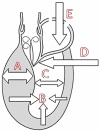The Importance of Left Ventricular Outflow Tract and Mid-Ventricular Gradients in Stress Echocardiography: A Narrative Review
- PMID: 37629333
- PMCID: PMC10455989
- DOI: 10.3390/jcm12165292
The Importance of Left Ventricular Outflow Tract and Mid-Ventricular Gradients in Stress Echocardiography: A Narrative Review
Abstract
This review aims to serve as a guide for clinical practice and to appraise the current knowledge on exercise stress echocardiography in the evaluation of intraventricular obstruction in HCM, in patients with cardiac syndrome X, in athletes with symptoms related to exercise, and in patients with normal left ventricular systolic function and exercise-related unexplained tiredness. The appearance of intraventricular obstruction while exercising is considered rare, and it usually occurs in patients with hypertrophy of the left ventricle. The occurrence of intraventricular obstruction when exercising has been evidenced in patients with hypertrophic cardiomyopathy, athletes, patients with cardiac syndrome X, patients with syncope or dizziness related to exercise, and patients with dyspnea and preserved ejection fraction. The clinical significance of this observation and the exercise modality that is most likely to trigger intraventricular obstruction remains unknown. Supine exercise and lying supine after exercise are less technically demanding, but they are also less physiologically demanding than upright exercise. Importantly, in everyday life, human beings generally do not become supine after exercise, as takes place in post-exercise treadmill stress echocardiograms in most echocardiography labs. The presence of induced intraventricular obstruction might be considered when patients have exercise-related symptoms that are not understood, and to assess prognosis in hypertrophic cardiomyopathy.
Keywords: angina; athletes; exercise echocardiography; hypertrophic cardiomyopathy; intraventricular gradients; syncope or dizziness related to exercise; tiredness with normal systolic function.
Conflict of interest statement
The authors declare no conflict of interest.
Figures





References
-
- Elliott P.M., Anastasakis A., Borger M.A., Borggrefe M., Cecchi F., Charron P., Hagege A.A., Lafont A., Limongelli G., Mahrholdt H., et al. 2014 ESC Guidelines on diagnosis and management of hypertrophic cardiomyopathy: The Task Force for the Diagnosis and Management of Hypertrophic Cardiomyopathy of the European Society of Cardiology (ESC) Eur. Heart J. 2014;35:2733–2779. doi: 10.1093/eurheartj/ehu284. - DOI - PubMed
-
- Sherrid M.V., Bernard S., Tripathi N., Patel Y., Modi V., Axel L., Talebi S., Ghoshhajra B.B., Sanborn D.Y., Saric M., et al. Apical Aneurysms and Mid-Left Ventricular Obstruction in Hypertrophic Cardiomyopathy. JACC Cardiovasc. Imaging. 2023;16:591–605. doi: 10.1016/j.jcmg.2022.11.013. - DOI - PubMed
Publication types
LinkOut - more resources
Full Text Sources

